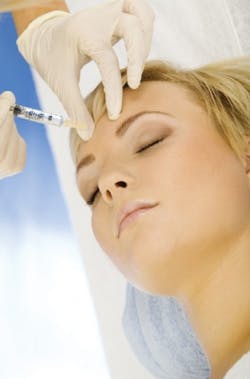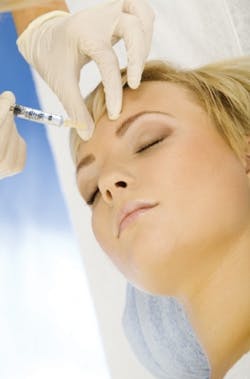The journey into total facial esthetics with Botox
by Peter Harnois, DDS
For more on this topic, go to www.dentaleconomics.com and search using the following key words: cosmetic dentistry, Botox, dermal fillers, dental esthetics.Twenty-eight years into practicing general dentistry, my office manager and wife, Beatriz, came across an e-mail from the American Academy of Facial Esthetics (AAFE), www.facialesthetics.org. I have to admit I was intrigued at the prospect of being properly trained to offer Botox and dermal fillers as services at my two dental offices in Chicago and suburban Hinsdale. What concerned me was what I thought I knew about the action of Botox. My wife told me that if I did not take the course, she would go to a dermatologist or plastic surgeon to have this done. Upon hearing that, I decided I could at least give up two days to take the course and better understand what all the buzz was about.Beatriz signed me up and went as my assistant so she could better understand how to implement this into our Michigan Avenue practice. I have taken so many courses over the years since I graduated from the University of Illinois College of Dentistry. The AAFE two-day course we attended turned out to be the most organized and focused course I had ever taken. Dr. Louis Malcmacher presented and trained us in a most effective and easy-to-understand manner.
The first morning dispelled all my own myths and misconceptions about what Botox was really all about. The course covered not only the history of Botox, but its mechanism of action. I was very surprised to learn that Botox does not paralyze the muscles; rather, it decreases motor activity. I became excited when everyone from my hairdresser, Judy, to my own wife told me that if I offered this at my offices, they would be my first patients and refer their friends and family.
When we first checked out the AAFE Web site for a Level I course on Botox and dermal fillers, one thing that intrigued me the most was being able to bring our own patients to practice on. This was a tremendous advantage as we could monitor the success of the treatment and see for ourselves how these procedures worked. In all the CE I have taken over the years, I had never had the opportunity to do something like this.
One of the best parts of the morning was the facial anatomy lesson. The AAFE's approach is anatomically based, which makes it much easier to understand how to treat patients with Botox and dermal fillers. Dr. Malcmacher reminded us that dentists are the best injectors of any health-care provider, because we have been trained on proper injection techniques from the very beginning of our careers.
Based on the anatomy, Dr. Malcmacher taught us where and how to inject each facial area for both cosmetic and therapeutic uses, including TMJ, bruxism cases, and facial pain. There was a lot to learn: Botox reconstitution, dosing, indications, adverse reactions and how to avoid them, and more.
The hands-on, live patient session was simply outstanding! We observed and performed a wide variety of Botox procedures during the afternoon of the first day. The AAFE faculty closely supervised our initial technique, making sure we knew how much Botox we were administering, where it was going, and what it would do.
I have to admit that I was nervous at first, but as I began performing these techniques, it became immediately obvious that this was well within my skill set. I left that first day with many thoughts and ideas. I had not felt this well trained so quickly and efficiently in any course I had ever taken before. I could not wait to come back for the second day and develop yet another new skill to further my thirst for knowledge and technique for my budding practice of "Total Facial Esthetics"!
As I sat there the next morning, I started to see the scope of how this course on the use of dermal fillers was going to forever change the way I practice dentistry. We learned the chemistry, proper indications and use of dermal filler therapy and how it fills out the folds in the oral and perioral areas, as well as subtle lip augmentation for both cosmetic and therapeutic uses such as gummy smile and angular cheilitis. I learned about hyaluronic acid substances, which are quite safe and effective when used properly to volumize a person's face and temporarily reverse the effects of aging in a natural manner.
I did not know much about what dermal fillers were, but the course material was presented logically so that I could move forward and confidently inject my first patient right after the morning lecture. Placing dermal fillers in a pain-free manner involves what we do best. Anesthetizing our patients puts us into an entirely different realm of pain control for what our own patients have been enduring with dermatologists and plastic surgeons. I have become a hero to my patients and staff who badly want this done but were previously terrified or turned off by a very painful experience with dermal fillers.
While Botox takes a few days to begin showing its effects, dermal fillers produce immediate results. It was exhilarating to see that happened as I injected the dermal filler Juvederm into my patient. What can be done with this product when used by a properly trained clinician opens up another rewarding and lucrative dental procedure that can be easily implemented into our daily operation. Who better to enhance someone's smile than a dentist, who studies smiles on a daily basis.
By the end of the second day, I was prepared to implement these new procedures into my practice. We received well-organized, easy-to-understand training manuals to which I often refer, plus all of the forms to give to patients for pre- and postoperative instructions, including consent forms. We also received a clear list of materials we needed to get started. All we had to do was call our supply company, and we were ready to go! There was no expensive starter kit to purchase or complicated process to put into action.
There are so many areas of dentistry that require a huge initial capital investment, which prevents many dentists from diving in. However, this is not the case with Botox and dermal fillers. All you need is the education and live patient experiences so that you will become well trained. The cost of the adjunctive materials you need to buy is literally pennies per patient; the cost of the Botox and dermal fillers directly relate to the patient fee.
Once I completed my training with the AAFE, my public relations and marketing juices were flowing. I already had a well-established patient base and could not wait to get back to the office to start training my staff and educating my patients about our new service! I walked out of that course all fired up to start offering this service as soon as possible.
The buzz that was created at my Hinsdale office when I told them I was taking a two-day training course on Botox and dermal fillers totally caught me by surprise. My staff of 13 all told me how much they wanted to be my first patients. I had never seen them so excited by a job "perk." Who doesn't want to look younger? What was even more revealing to me was the fact that they would only have this type of procedure done if it was from someone they knew and trusted. I realized I would look at my patient base differently from then on, and I saw an entirely new and exciting opportunity for my practice.
One year later, we have established ourselves as a leader in our area, providing Botox and dermal fillers within my general dental practice. We have expanded our patient base and production in a very healthy and positive way. Our patients keep referring their friends and family because the word is out that we are "the office" to have this procedure done in the most comfortable and thorough manner. When we call our patients the night of their procedure to see how they are doing, they are in shock and tell us the medical offices they went to before never did that. The forms we print out from the course CD allow us to show our patients how much we care about them.
Like anything else, once you begin in a new area of expertise, you want to continue to grow. I have since been to the AAFE Level II course, which has allowed me to add even more services to my office. I also use their training DVDs as a reference and for staff training. I watch these regularly so I can provide the best possible care and results for my patients. It is a wonderful review system.
My practice has always emphasized minimally invasive dentistry, whether it be caries risk, veneers, or periodontal and restorative procedures. By taking the AAFE courses, I have become a real hero in the eyes of my patients, staff, and family. I am producing more per hour with these procedures than almost any other procedure I offer, and I am also expanding my patient base. This is such fun, and at 54 I feel rejuvenated again. These courses have altered my career path forever!
Dr. Peter Harnois runs two successful esthetic practices at One Magnificent Mile in Chicago and in suburban Hinsdale, Ill. A nationally recognized leader in minimally invasive total facial esthetic techniques, he was an assistant professor of oral diagnosis at the University of Illinois College of Dentistry and is an active member of the American Academy of Cosmetic Dentistry. He is a faculty member and fellow of the American Academy of Facial Esthetics.

